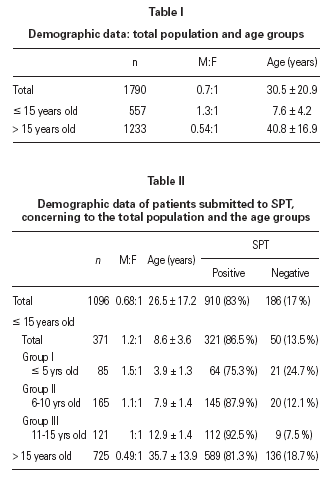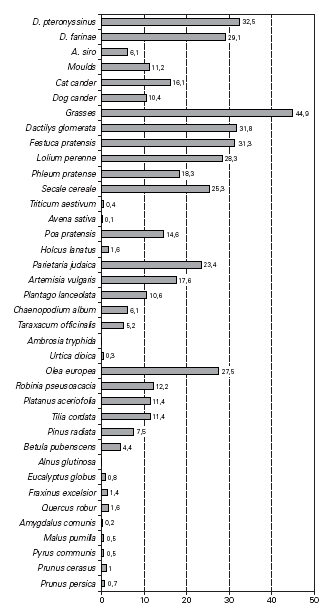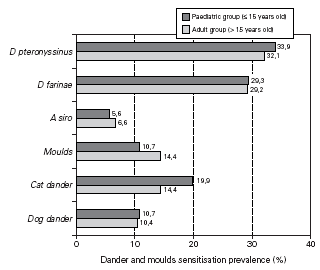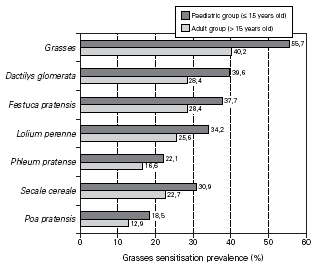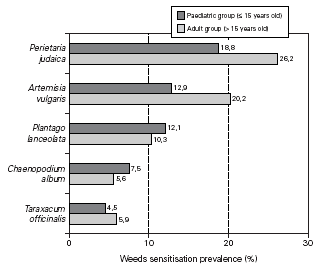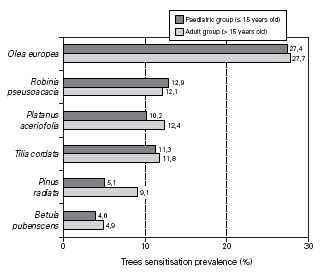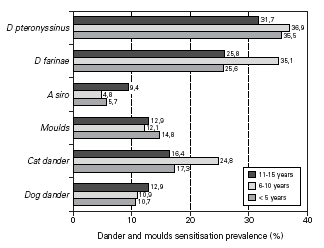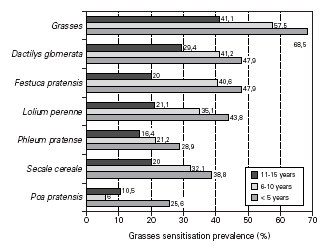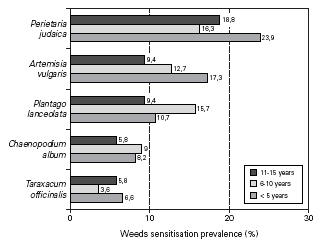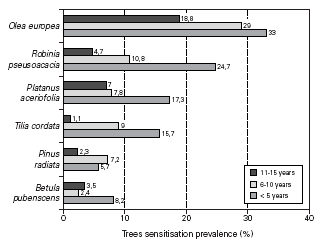Cova da Beira is a inland central region of Portugal, located in the latitude 40° 16', the longitude 7° 30' and in the altitude of 600 m above the sea level and has a continental climate.
The local flora includes Castanea, Olea, Pinus, Ficus, Eriobotrya, Acácia, Prunus, Platanus, Pseudotsuga, Tília, Rubus, Ailanthus, Cytsisus, Umbilicus, Rumex, Parietaria, Mercurialis, Polypodium and Sedum. The gardens in this city includes Vitis, Arundo and Anagallis, Brassicaceae Labiatae, Compositae, Tilaceae and Platanaceae. In the valley of this region there are cultivated fruit trees.
In the first polinic map carried out throughout the whole country (March 1999-March 2000), this area had the highest pollen counts in Portugal (SPAIC/ Schering-Plough) 1. The genera more frequently identified were Olea (31 %), Castanea sativa (21 %), grasses (7 %), Urtica type B (5 %), Urtica type A (5 %), Platanus (5 %), Ailanthus (2 %), Rumex acetosella (1 %), Cupressacea (1 %), Quercus deciduous (1 %), Quercus coccifera (1 %) and other polens (16 %).
The 93 000 inhabitants of this region constitutes a homogeneous population (without any external interferences, namely migration).
Skin prick testing (SPT) is a simple method to determine sensitisation to aeroallergens in epidemiologic studies 2.
The aeroallergen sensitisation prevalence in general population is related to different factors. In each region, the sensitisation reflects the allergens exposure and the influence of other environmental factors such as pollution 2-5.
Nowadays, the different aerobiology networks in Europe, using the same methodology, made available data concerning pollen concentration of different species 6. But it is very difficult to compare the different clinical studies available on literature, because of the heterogeneity of the design, the very discrepant samples, and the different aeroallergens tested. The Position paper published in 1998 is a relevant document that extensively analyses all the studies concerning pollen sensitisation in Europe 3. The EFA study, performed in 2000 7, showed the impact of the allergic diseases in 10 countries, and this information was consistent with the European Allergy White Paper contents 8.
The aeroallergen sensitisation prevalence studies in paediatric patients reveals predominance of house dust mites (HDM) sensitisation comparing to pollen sensitisation 9-12.
The aeroallergens sensitisation in this region has never been studied before. The aim of this study was to assess the aeroallergens cutaneous reactivity in an allergic population of Cova da Beira, as well its prevalence according to different age groups.
METHODS
During a five year period, from May 1995 to May 2000, 1790 consecutive outpatients were observed for suspected allergic symptoms. In the first observation some patients were submitted to skin prick tests (SPT) to aeroallergens (ALK-Abelló, Spain), including at least 20 local flora species: Dermatophagoides pteronyssinus, Dermatophagoides farinae, Acarus siro, Blatella mixture, moulds mixture, Candida albicans, cat and dog dander, grasses mixture, Parietaria judaica, Artemisia vulgaris, Plantago lanceolata, Chaenopodium album, Olea europea, Robinia pseudoacacia, Platanus acerifolia, Tilia cordata, Pinus radiata and Betula pubenscens. According to the clinical history there were performed SPT with other aeroallergens such as storage mites and another pollen allergens including: Dactylis glomerata, Festuca pratensis, Lolium perenne, Phleum pratense, Secale cereale, Triticum aestivum, Avena sativa, Poa pratensis, Holcus lanatus, Taraxacum officinalis, Ambrosia tryphida, Urtica dioica, Alnus glutinosa, Eucalyptus globus, Fraxinus excelsior, Quercus robur, Amygdalus communis, Mallus pumilla, Pyrus communis, Prunus cerasus and Prunus persica. SPT were performed according to international guidelines 2. It was considered positive for a wheal > 3 mm above the negative control.
We included in this study all the patients who were submitted to SPT. We divided the total population in two groups of patients, according to age. The paediatric patients (# 15 years old) were divided in three age subgroups: group I including children # 5 years old; group II including children from 6 to 10 years old; and group III including children from 11 to 15 years old.
We analysed the aeroallergens sensitization prevalence of the total population and according to the age groups.
RESULTS
During a 5 year period (1995-2000), 1790 consecutive outpatients were observed for suspected allergic symptoms. 557 patients were included in the paediatric group (# 15 years old) (table I).
1096 patients were submitted to SPT, including 371 paediatric patients (table II). These paediatric patients were divided in three age subgroups: group I included 85 children, group II included 165 schoolchildren and group III included 121 adolescent (table II).
The figure 1 represents the aeroallergens sensitisation prevalence in the total population. The aeroallergens sensitisation prevalence in the paediatric group, compared to the adult patients group, is represented in figures 2, 3, 4 and 5). Figures 6, 7, 8 and 9) represents the most relevant aeroallergens sensitisation prevalence in the age paediatric subgroups.
Figure 1.--Aeroallergens sensitisation prevalence in total population (%).
The Triticum aestivum, Avena sativa, Holcus lanatus, Urtica dioica, Alnus glutinosa, Eucalyptus globus, Fraxinus excelsior, Quercus robur, Amygdalus communis, Mallus pumilla, Pyrus communis, Prunus cerasus and Prunus persica sensitisation prevalence is not represented in the graphics because it is under 2 %, in total population and also in the age subgroups.
DISCUSSION
The population studied showed a high aeroallergens sensitisation (83 %) with the paediatric population presenting the highest values (86.5 %) compared to the adult one (81.3 %).
The cutaneous reactivity to the tested aeroallergens revealed a sensitisation prevalence in the general population: grasses mixture (44.9 %), D. pteronyssinus (32.5 %), D. farinae (29.1 %), Olea europea (27.5 %), Parietaria judaica (23.4 %), cat dander (16.1 %), Artemisia vulgaris (17.6 %), Robinia pseudoacacia (12.2 %), Platanus acerifolia (11.4 %), Tilia cordata (11.4 %) moulds mixture (11.2 %), Plantago lanceolata (10.6 %), Dog dander (10.4 %), and Pinus radiata (7.5 %).
Grasses sensitisation prevalence was the highest in the general population. The most relevant grasses species were Dactilys glomerata (31.8 %), Festuca pratensis (31.3 %), Lolium perenne (28.3 %), Secale cereale (25.3 %), Phleum pratense (18.3 %) and Poa pratensis (14.6 %). In several studies performed in other regions in Portugal the grasses sensitisation prevalence was lower 13-16, ranging from 12.6 % to 36 %, except in one study performed in Alentejo 17 (South of Portugal) that showed a prevalence of sensitisation to grasses similar to our study. However in the Alentejo population sensitisation to grasses was the second most relevant following house dust mites (HDM) sensitisation.
Grasses are important aeroallergens all over Europe 3. And they are the most relevant polinic aeroallergens in Portugal 13-21, and in Southern Europe 4.
Sensitisation to HDM was the second most important in this population. In other studies performed in other regions of Portugal 13-17,22,23, HDM sensitisation prevalence is the highest (from 14.3 % to 97 % 13-17,22-28) followed by grasses sensitisation.
The Olea europea sensitisation prevalence was the third most relevant (27.5 %) in this population. It was higher than in other portuguese studies 13,14,16, but similar to studies performed in Mediterranean areas 3,29,30.
Sensitisation to Parietaria was higher (23.4 %) than in other portuguese 13-15 and spanish 4,29 studies, but lower than in italian studies 4,30. Parietaria is a widespread plant in the south of Europe, mainly in the coastal areas reaching the highest ratios of sensitisation, and inducing bronchial symptoms usually severe in adolescent and young adult patients. However, there has been an obvious increase in children 31.
Sensitisation to moulds showed lower values compared to pollens, HDM and dander. Moulds sensitisation prevalence was 11.2 %, a similar value to those founded by other authors 23,32. However this result is very discrepant from other portuguese studies 14-16,33,34 showing lower values (3 %).
The polinic sensitisation has not been assumed to be relevant in paediatric patients. In this study we analysed the aeroallergens sensitisation according to age groups. We observed that sensitisation to grasses was the most relevant in the paediatric group (< 15 years old), followed by HDM, Olea europea, Parietaria judaica, cat and dog dander and moulds, in decrescent order. The same pattern was observed in the total population.
Comparing the paediatric and the adult groups (figs. 2-5) we observed that grasses sensitisation was greater in paediatric group (55.7 % versus 40.2 % in adult patients). Olea europea sensitisation was similar in paediatric and adult groups. Parietaria judaica sensitisation was lower in the paediatric patients. HDM, cat and dog dander and moulds sensitisation was similar in both age groups.
Figure 2.--HDM, dander and moulds sensitisation prevalence (%).
Figure 3.--Grasses sensitisation prevalence (%).
Figure 4.--Weeds sensitisation prevalence (%).
Figure 5.--Trees sensitisation prevalence (%).
Then we analysed the aeroallergens sensitisation in age subgroups. HDM, moulds and cat and dog dander sensitisation was similar in each age subgroup (fig. 6). We found that grasses sensitisation occurred in very young patients (41.1 % in subgroup I), and that grasses were the most relevant aeroallergen in this subgroup, followed by HDM. However grasses sensitisation becomes more important in subgroup II (57.5 %) and in subgroup III (66.5 %). This pattern is observed for each grass sensitisation (fig. 7), and also for Olea europea sensitisation (fig. 9) and the other trees. Concerning Parietaria judaica, sensitisation the subgroup II showed the lowest value and subgroup III the highest one. We observed that each weed presented a different sensitisation pattern according to age subgroups (fig. 8).
Figure 6.--HDM, dander and moulds sensitisation prevalence (%) in paediatric population.
Figure 7.--Grasses sensitisation prevalence (%) in paediatric population.
Figure 8.--Weeds sensitisation prevalence (%) in paediatric population.
Figure 9.--Trees sensitisation prevalence (%) in paediatric population.
The aeroallergen sensitisation prevalence in paediatric patients revealed predominance of house dust mites (HDM) sensitisation comparing to pollen sensitisation 9-12, also in European studies.
Pollen allergy is increasing throughout Europe in spite off a decrease in the grassland and tree land. There are obvious differences concerning pollen allergy in Europe. In the 5 main geographic areas defined by G D'Amato, birch is the main pollen inducing sensitisation in the Artic and Scandinavia; birch, grasses and pollen from trees of deciduous forests in the Central area; grasses, mugwort and ragweed in the Eastern countries; grasses and pollen trees in the Central Mountainous areas; finally in the Mediterranean area the main pollens inducing allergic diseases are grasses, Parietaria, Olea and Cupressus 3.
The ECRHS performed in 12 countries on individuals ranging from 20 to 44 years showed specific IgE levels to Phleum pratensis ranging from 3.8 % in Ireland to 15.6 % in Switzerland 35. In this country a large study performed in 9651 individuals, from 1991 to 1993, revealed similar values 36. The skin sensitisation to grasses was similar in adults and in children, 12.7 % and 12.4 % respectively.
In an interesting study of a cohort including 1456 subjects, in the Isle of Wight (UK) from 1989 to 1990 the children were submitted to skin prick tests at the age of 4 years 9. Sensitisation to grasses was 7.8 % (981 out of 1218 individuals), and it was the second most relevant aeroallergen sensitisation after HDM (11.9 %).
Pollen allergy sensitisation was demonstrated in 1101 random children aged 8 to 11 years from Freiburg school (Germany). 19.7 % were sensitised to pollens 10. The rates of sensitisation were low in Sosnowiec, Poland, on a random sample of 2000 children, 10.3-10.8 % 11.
In 1995 the Spanish Allergologica study evaluated the allergic sensitisation in 10 regions 12. Grass pollen was the major allergen inducing allergic complaints with a prevalence ranging within 22 % to 77 %. Olea europea allergy was more frequent in the southern areas, related to the olive tree culture, being irrelevant on the North. Parietaria sensitisation ranged from 0.9 % to 43.1 %, being more frequent in the coastal Southern areas. Allergy to Compositae (Artemisia vulgaris) and Chaenopodium pollen was reported to the Southern regions and the continental northern area of Aragon.
This study showed very low pollen sensitisation prevalence in small children (< 6 years old). The pollen sensitisation prevalence in children from 6 to 14 years old was: grasses 29.6 %, Olea europea 25.9 % and Parietaria judaica 5.9 %. These pollen sensitisation were greater in adults.
These studies represent the highly heterogeneity of sensitisation throughout Europe. The genetic, the climate, the geography, the local flora (changes related to the forest fires, agricultural methods and cultivation, importation of non-natives species), the pollution and the demography are probably responsible for these different patterns. It is very important to design studies that could be compared and could be representative of the different countries or regions.
We observed that pollen sensitisation has a great impact in Cova da Beira allergic population: Grasses sensitisation is the most prevalent in all age groups and sensitisation to other pollen shows high prevalence. In other studies performed in Portugal, as referred, HDM is the most relevant aeroallergen sensitisation followed by pollen sensitisation with lower values, compared to our study.
In the first pollen counts carried out throughout the whole country (March 1999-March 2000), this area had the highest values in Portugal. The weather, the local flora and the geographic characteristics could be some of the contributing factors to the long polinic peaks observed in this region. This could explain the early pollen sensitisation observed in this paediatric population.
Other environment factors, such as pollution, should be studied to characterize the aeroallergen sensitisation observed in this population. Indeed, the influence of pollution in pollen allergenicity is well described in urban areas. This is a homogeneous population, living in a well defined region of Portugal, without external influences such as migration.
In summary, the sensitisation to indoor aeroallergens, was similar in all age groups and it was less important than that of pollens. The prevalence of sensitisation to grasses was the greatest in all ages and the HDM sensitization was the second one most prevalent. The highest pollen counts in this region could explain the early sensitisation even in young children, but other factors such as the pollution/environmental exposure (urban versus rural) has to be studied to understand the high rates of pollen sensitisation founded in this population, including in the paediatric groups.




